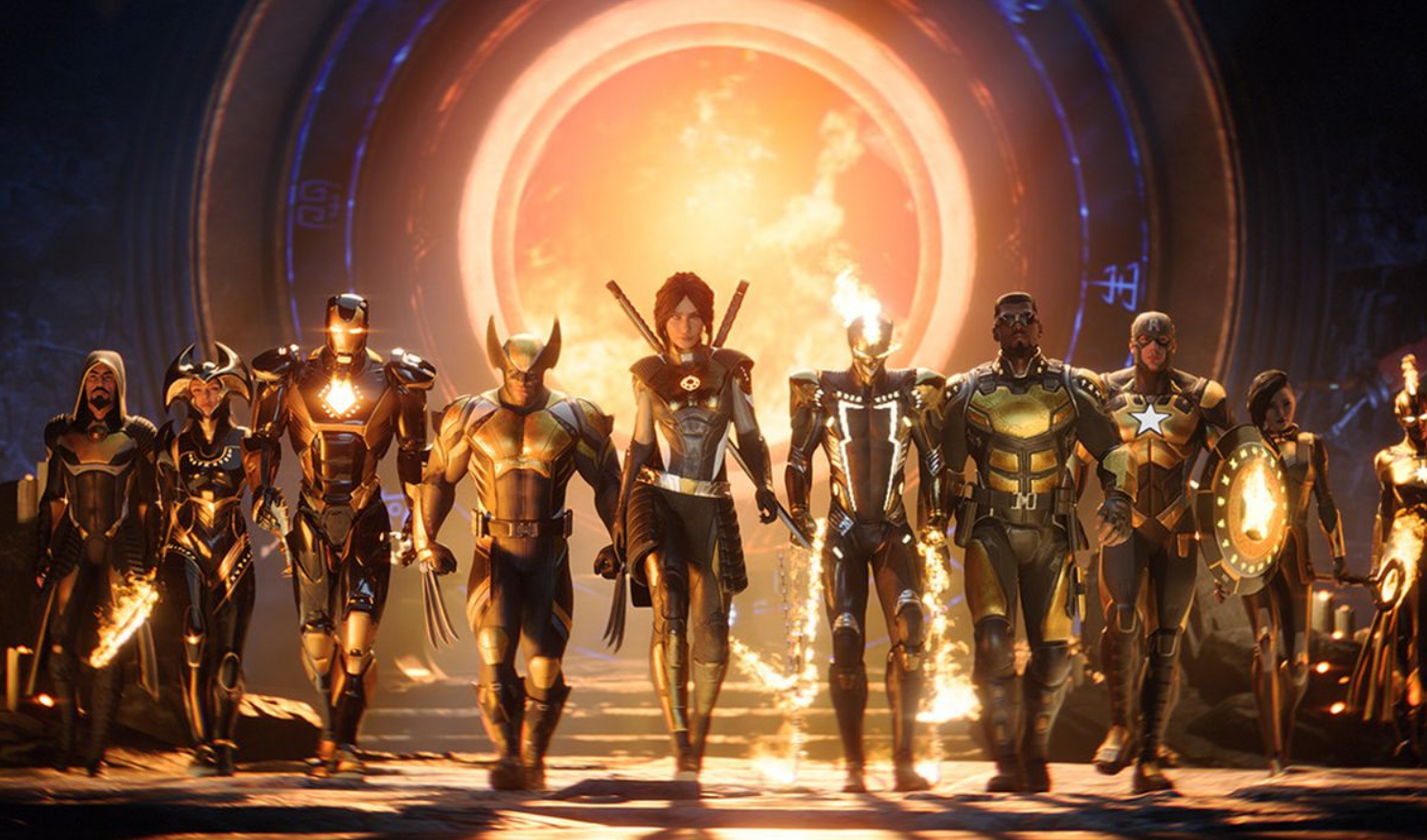Marvel’s Midnight Suns. It’s got the ‘Marvel’ right there in the title so that you remember, it’s A, about those particular Superheroes, and B, we own them! It’s also the latest long-awaited release from Firaxis, the developers behind the wildly popular and game-changing XCOM series.
However, I kinda want to keep talk about XCOM too as little as possible. Midnight Suns is a very different beast, trying to achieve something new and in a sense trying to redefine what an action/strategy title is in the modern gaming space. I mean, on paper Superheroes confined to a tactics framework makes little sense – they can fly etc, they can’t be constrained! So it’s about throwing off a lot of constraints that the genre usually comes bundled with. Midnight Suns isn’t grid-based and it’s not real-time – its combat is a whole new thing with almost free movement. Outside of combat, it’s a lot of western Mass Effect-style RPG, a lot of XCOM for sure, lashings of Marvel and too much mobile influence, but the game it had me thinking of most often was Persona 5.
We’ll get into why as we go. For now, going in, the elevator pitch is your favourite Marvel Superheroes, boots-on-the-ground in pitched turn-based battles. There’s card-based moves, deck-building, relationship tracking, Super Team management, cosmetics, superhero bants, a coven to explore, and an arcane witchy story full of strong female characters to hold it all together. We got a lot of ground to cover, but is it any good?
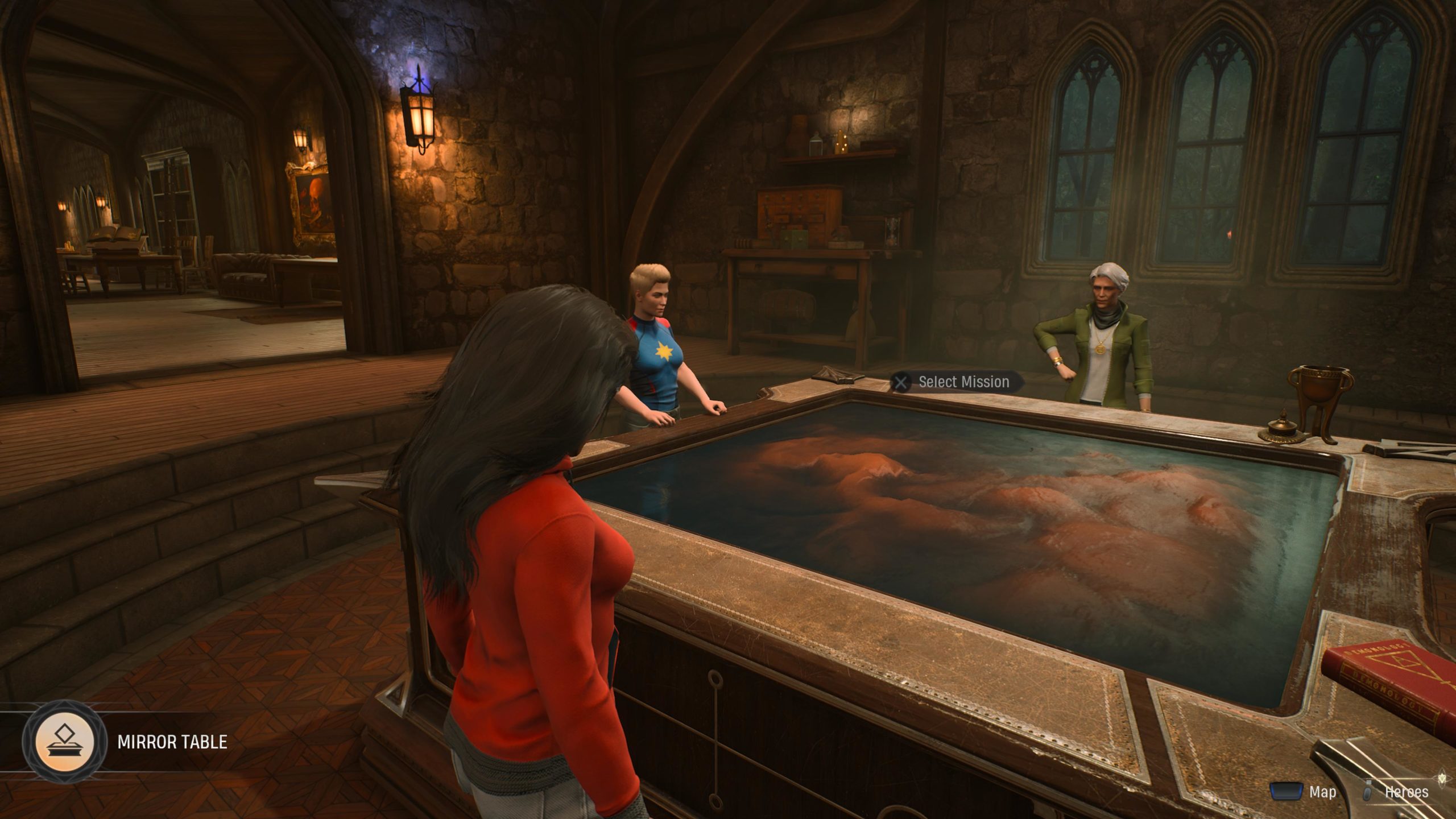
Hail Hyrda?
Of course we love to see our heroes anyway, but it’s best when there’s a good story to hang everything on. And while Midnight Suns may not be the most ambitious narrative in video games this year, it more than holds up and keeps the action moving.
A quick synopsis, because I don’t want to spoil anything: Those nefarious evildoers at Hydra have gone and got all mystical Marvel on us. They’ve done the one thing that you should never do with ancient coffins – open them and raise the creature within. I mean, there are movies warning against that stuff. From the depths of these rituals is reawakened the dark brood mother Lilith, intent on the subjugation of the world. She takes control of Hydra, locks Doctor Strange outside his own Sanctum Santorum, and traps Wanda inside.
Earth’s heroes need to band together to hold off Lilith’s onslaught, but it’s the magical side of Marvel that is needed and the Avengers don’t really cut it alone. In answer to this universe-threatening evil, Strange seeks out the Caretaker and the Midnight Suns, a little coven-like group of supers who are a bit more arcane than Averager – Ghost Rider, Blade, Ilyana of the New Mutants, and Nico from Runaways for example. Now the two teams need to work together, and the dynamic between them provides much of the conflict and the camaraderie too.
The Midnight Suns reside in the Abbey and watch over The Hunter, a brand new Marvel hero just for the game. She’s the reanimated child of Lilith, trained to fight her whenever she should awaken. Perfect. That’s just what we need right now. The Hunter is you, your avatar as you make friends, explore and fight. Her backstory is heavily linked with Agatha Harkness, and makes for some of the most interesting story beats in the game – origin stories always are the best superhero stories. It’s also nice that it all fits into the recent Phase 4-type shared mythos – that of Strange and the Multiverse of Madness, the Darkhold spell book, Wandavision and her nemesis Agatha Harkness.
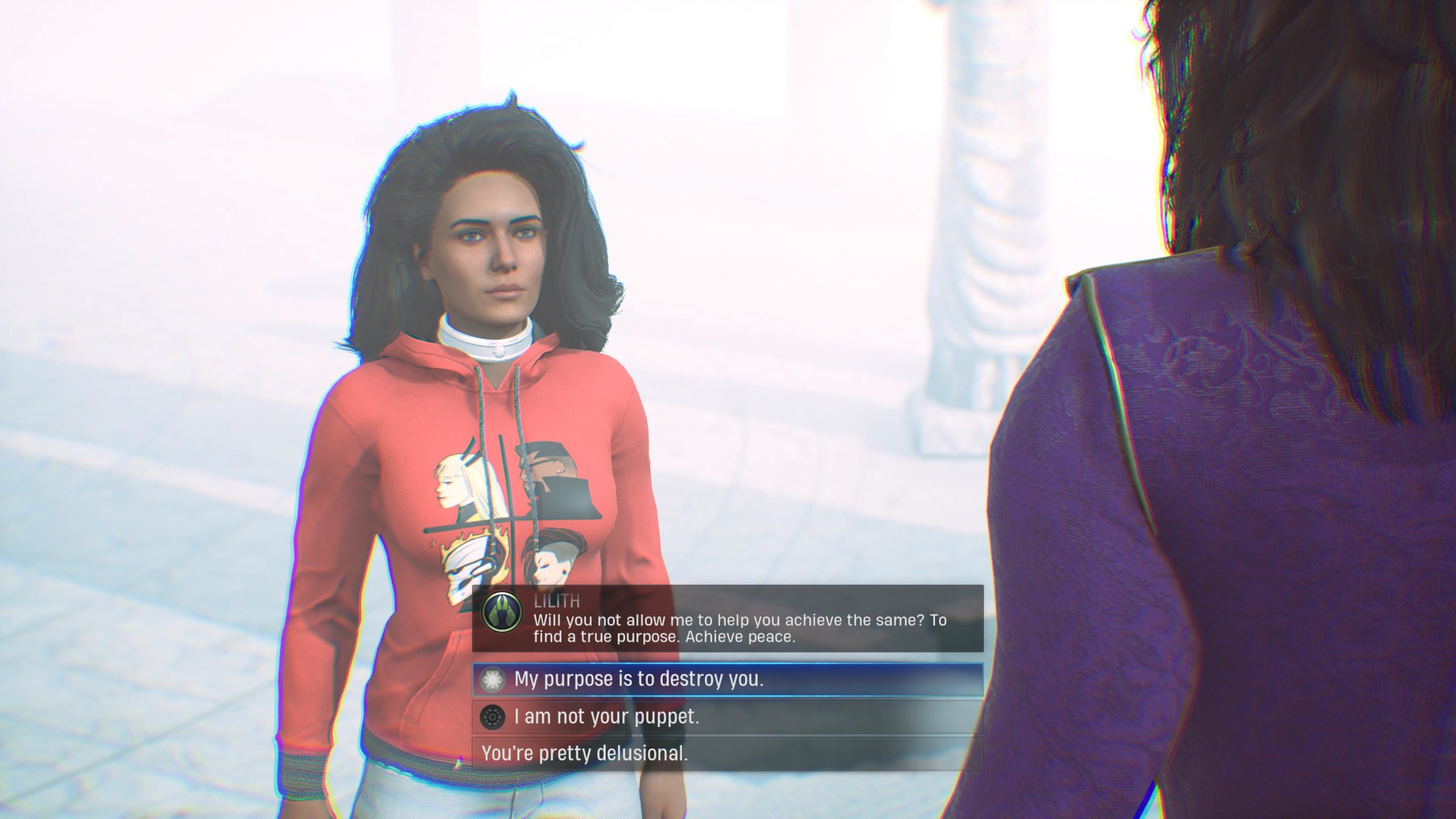
Marvel Team-up
The game struggles a little with the exposition, like in really giving tangible reasons for things, such as why Lilith wants to destroy everything, but it’s kind of deliberate. Instead, it thrusts you straight into the meat of the story, Lilith awakened, heroes together, Midnight Suns reformed, all in the space of a mission or so. It doesn’t feel like the beginning of a Marvel movie, and lacks that equilibrium-establishing setup, for better or worse. Much of the story from this point is a strongly told back and forth between the forces of good and evil, mostly across New York City (although there are other locales), slowly and confidently revealing new heroes and villains in story missions, before bringing them into the fold of the Midnight Suns or defeating them.
It’s also strong from a character perspective – each and every hero you recruit then has masses of interactions available at the Abbey, relationship meters, rewards, special scenes and dialogue. You can get to know them and their backstories, answer their questions and help with their problems and this provides for a rich amount of world-building even if the plot isn’t all that memorable. It’s Lilith that made it unmemorable for me – she may be threatening everything because our heroes don’t know how to counter her arcane magics, but she’s not Thanos – her motivations are unclear, she doesn’t have much in the way of presence, and she rarely interacts with anyone but the Hunter. She’s a very forgettable big bad in light of everything else the game does so strongly.
I’ve mentioned the Abbey and that is an important thing to cover – it’s going to be where you spend a good 50% of your time. But for everything in the Abbey to make sense we need to talk combat first.
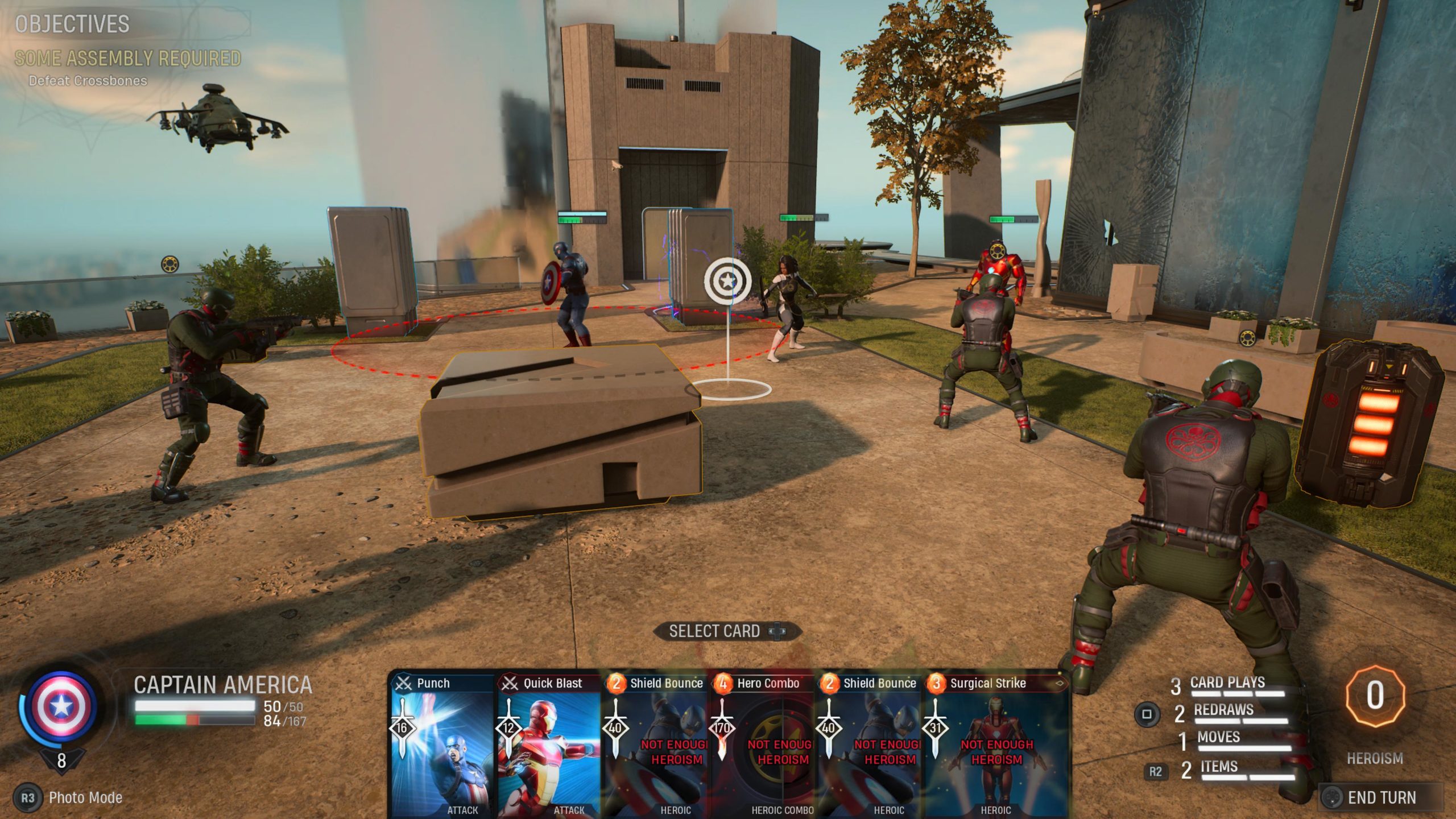
Deck Building For A Decking
I generally don’t like cards in videogames, and have no interest in deck-building – it’s a genre I generally leave well alone as it gamifies things a step too far for me. So it’s some testament to Midnight Suns that its card-based combat did not turn me off, and in fact went some way to convincing me of their merit.
Combat in Midnight Suns is a boots-on-the-ground 3D tactics arena. You take 3 superheroes in, each packing a deck of 8 moves – 4 attacks and 4 defensive or skill-based moves. The cards are dealt as a group, and therefore really enhance the team feel – you don’t have two moves as Blade every turn, you have 3 card plays as a team. This brings everyone into the fray. But of course, as a result it’s heavily randomised.
You might draw terrible cards and have to use up redraw options. Or every card might be for Captain Marvel, or just that hers work best at decimating the array of enemies, and give the most Heroic points, and then end in a heroic move. It adds an element of cohesion to the team dynamic, but across multiple randomised plays.
Attacks build up a Heroic gauge which can be used to play big damage cards, area attacks etc but it’s a resource you are always trying to build up and use every round. Heroic points also allow for use of the environment. Every stage/arena is littered with junk, pallets, explosives, stacks of newspaper, you name it, just waiting for our heroes to use up a point, instead of a card, and throw it at an enemy. Plenty of attacks feature Knockback, which can be used to double the damage by hitting enemies into obstacles, each other, or worst of all, the waiting blades of a teammate.
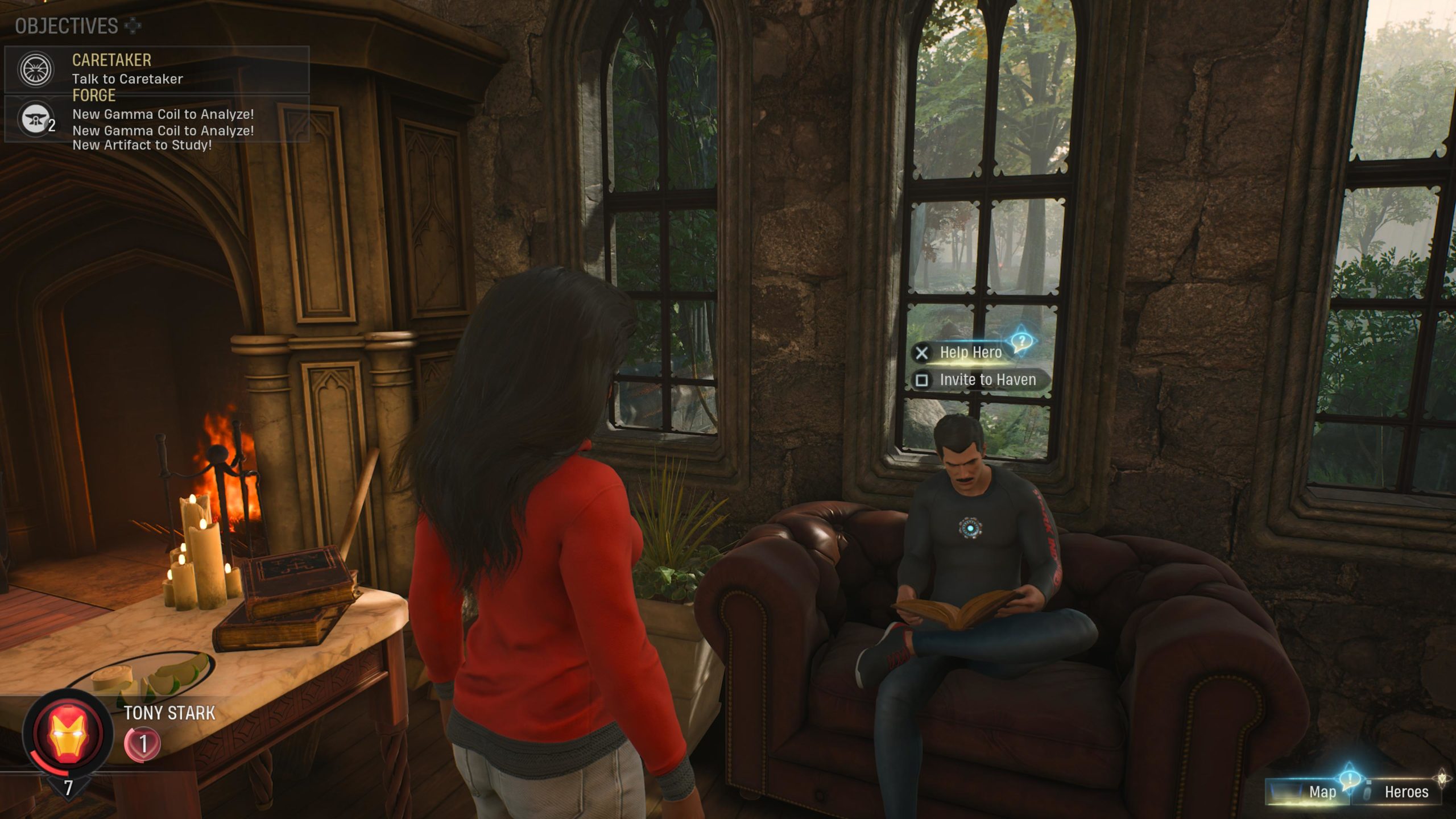
Avengers… Assemble
Because of all this, positioning matters a great deal as you might expect in a tactics game, but traversal doesn’t. You’ll never be using turns to creep across the map to reach distant objectives – there’s no maximum distance to movement really. This means there’s no maximum range either – you can hit anyone in the area, and anyone can hit you. It’s all to do with who these characters are – why constrain Spider-Man to a grid – he can web sling anywhere around in an instant, Iron Man can fly, Magik can teleport. By allowing these SuperHeroes to be themselves, and thereby removing distance as a factor in encounters, Firaxis has reinvented the subgenre.
It’s a liberating way to play a tactics game. I consider myself an experienced tactics player, and I had to throw out a great deal of practiced modus operandi. You suddenly have to be aware of every enemy, not just those you think are in range – they’re all in range. You have to take every opportunity, no matter how small, because you will get overwhelmed and fast.
Enemies and bosses also serve to make things interesting. Hydra grunts come in a number of shapes and sizes, but two particular types. Ones with health and those that are one shotters. Ones with health clearly need to be chipped away at with more than one attack, but one shotters only take one hit – no point wasting big damage on them, but perhaps they could be thrown into their colleagues, or used in a chain or the centre of an area hit. The trouble is the system often deals you enemies in waves – one-shotters can still hit just as hard so you need to use up valuable moves and card plays to take down as many as possible each round.
The rub, and something I found quite unfair, is that every enemy gets a move after your turn. You only get the 3 card plays, whatever you can do with the environment, and any skills that add more. Once it’s over, you have to take your punishment from everyone on the map. I often wished they were limited to 3 card plays too.
Lastly, bosses throw out the rules again. Large health blocks, immunities, and then to cap it all off most have multiple health bars and need to be killed more than once. Then they like to randomly appear in basic missions as well just when you thought you might take a breather. There are no breather missions in Midnight Suns, the difficulty level is high and the grace period is really just up to level 5 or 6 – from that point you will start to face heavy opposition, start getting wiped out completely, start needing to revive comrades. Thankfully Firaxis has not employed its permadeath XCOM mechanics here, but a KO’d or even injured Hero will not be able to join another mission for a number of in-game days.
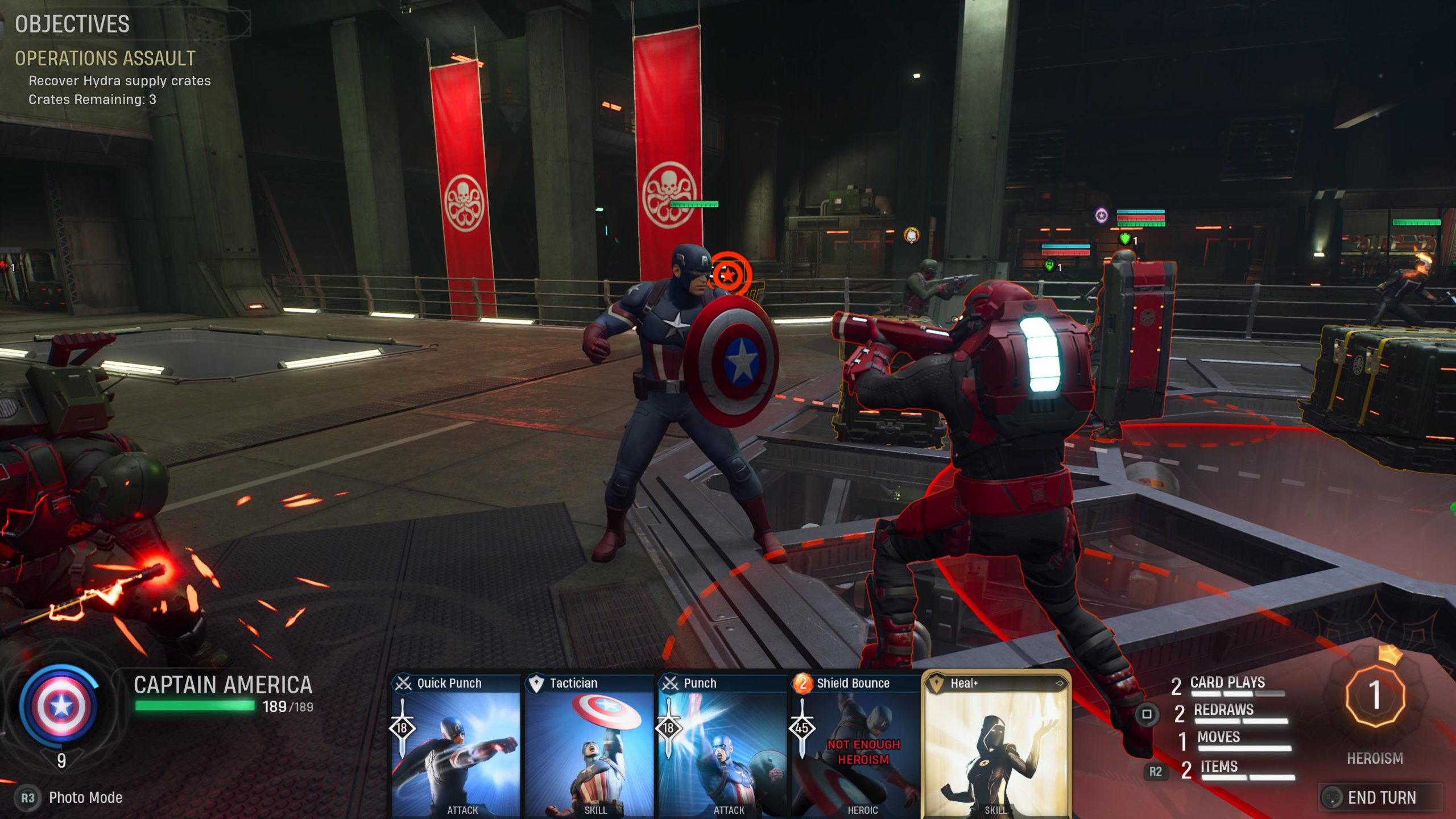
Home Is Where Your Ironheart Is
So when you aren’t throwing down against Hydra and arrayed Marvel villains, you’ll spend most of your time at the Abbey, and it can be a satisfying little place to ‘live’ in for a while. It made me hungry for a modern X-Men game of this quality where I could wander about Xavier Academy, but hey, everyone has their favourites. I’m always a fan of nice hub areas with stuff to do, rooms to decorate, war rooms, and bants with all the heroes just wandering about the place. I mean, they are sitting around playing PlayStation, while I’m sitting around playing PlayStation, it’s great!
As the game progresses the Abbey gets more and more accessible, but more importantly, it becomes more than just a hangout between missions. It’s a full-on management centre for your own version of the Avengers. Imagine you’re Nick Fury, but you really like getting into the admin. You can set off research projects that take in-game days to complete to gain cards and combat items, or you could send heroes from your roster out on solo Hero Ops – you can only have 3 in your squad so I’m glad there’s a system to get a few others working and not just freeloading, sorry hanging out, in the Abbey all day. The downside to some of these systems is they can feel like mobile gaming-type delayed services – you know the type – practices that keep you logging in or waiting, unless you’re prepared to part with cash – you don’t have to part with cash here, it just feels like that kind of system. You end up spending as long managing the team at the Abbey as you will in combat. It’s not a criticism, but for some players the necessity of the Abbey sections will drag.
The payoff can often feel pretty limited too. A whole mission to secure a mystical crate, only to open it in an underwhelming fashion and discover a research job that then takes a day to give you a card. You may not end up even using the card, or it might be a duplicate or it just doesn’t appear in your hand for three fights – this kind of thing can make payoffs seem intangible. It’s a lottery. Sparring is another one – you can go out in the yard and spar with another hero. I was expecting a fun mini version of the battle system or even a full one-on-one fight. Nope, you get a single image of the fight and a notice to say the sparring was completed. Here’s some EXP, some relationship points, and some in-game currency. It’s very underwhelming. I tended to gravitate to the other areas of the game where there were more immediate gains to be made – combat, conversations with Marvel Heroes – and more tangible play.
It’s here in the Abbey where I really felt the structure of Midnight Suns really reveal itself. Think of the flow of play like it’s Marvel’s version of Persona 5 Royal. The Abbey is your school, you need to keep up with friends, relationships and work, superhero business and management, exploring the school grounds etc and all the tiny incremental improvements it’ll all make to combat. Each morning you perform the tasks of the morning, setting off management and sparring tasks etc, spend the day in Mementos — sorry on a mission in combat, then come back and hang out or pursue an activity that ups your social standing with other heroes. Then literally find your bed and go to sleep, each and every day. And then repeat.
Sorry, it’s not like Persona. It is Persona.
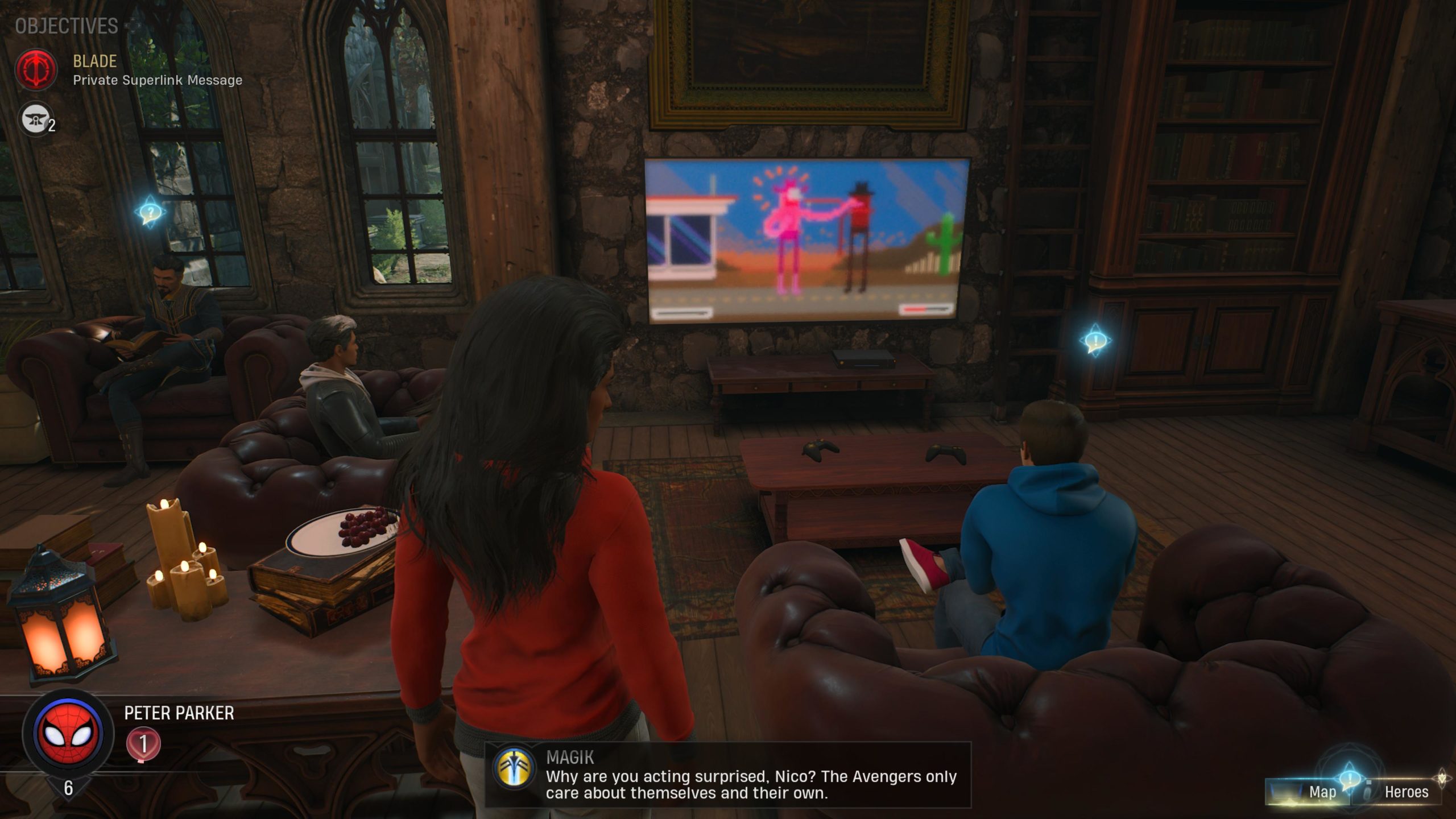
I Can Do This All Day
Graphically Midnight Suns isn’t playing at the level of the big AAA releases. Character models and locales certainly don’t look cutting edge and could be easily handled on last-gen if not before. That said, it all looks nice for what it is, character models are good and all the heroes look right, even if they don’t have a Hollywood actor’s face. I never had cause for issue with the graphical style, and only a few small instances of texture pop-in when a new stage loaded or the Abbey reloaded.
Cutscenes and dialogue are handled well. It really does feel like a convincing Marvel property, so Firaxis should be commended for upping its direction and storytelling skill quite considerably with this release. Marvel assets also help, such as music that harks back to the movies and uses famous themes. The voice talent on display was also great. Carole Danvers, Peter Parker, Tony Stark were among the best of a whole cast that was tightly performed and all felt like they’d been playing their respective character for a decade.
So just a few final issues to mention before we wrap this up. One of the most egregious is the lack of a pause button during cutscenes. I lost track of a number of cutscenes because I was unexpectedly called away (life happens even when you’re gaming, right) and I’d come back to find the cutscene had carried on regardless, finished, and Hunter was just standing there waiting for me. Well, I’ll just have to guess how that ended then. It’s also the case in dialogue too, so be warned. For a single-player game, with no multiplayer element, it’s an odd omission.
As a warning, there are microtransactions, but they are confined to cosmetics – suits, accessories, and the like. You can pay for almost everything using the in-game cosmetics currency Gloss, but if you want these dozen or so specific suits its real-world money spent. Not bad really.

Sweet Christmas Wishlist
I’ve been hankering for a top-down Marvel game ever since the X-Men and Marvel Legends games from the PS2 era. In my opinion, a series that didn’t get the recognition it deserved. Of course, this is a different style of game in many ways – tactics instead of Diablo-esque gameplay to say the least – but Midnight Suns reminded me of those old games more than it did the recent Avengers mess.
Midnight Suns is doing a hell of a lot right; the cohesive team-feel; the layered systems built on systems that complement and reinforce each other; the brand-new way of making a tactics stage actually move and function with superheroes. The free movement system is a bit fantastic and has me hooked to the combat loop.
On the flipside, there are probably too many systems for any casual gamers to penetrate this title. The amount of explanations at the beginning, the difficulty that then rears its head, the slow pace of the story and the management sections in the Abbey – many of these elements are going to disinterest a lot of players. I was paying an insane amount of attention in order to write this review, but even I lost track of some of the systems until much later. There was a way to fight with your demon dog Charlie as your teammate, but after the first time, I didn’t even find that mode again for a dozen hours.
If you are the type of person who hears tactics management systems, turn-based combat, and deep tactical gameplay, know that this is exactly the game for you. It’s certainly ticking a lot of my boxes, even if objectively I can see areas where it will lose people. It’s one of the most high end tactics titles out there, and its a well-made Marvel RPG to boot.
Midnight Suns evolves the tactics genre in a new way and is bursting with lore and Marvel curios. The roster of characters is fantastic and I’ve barely hinted at half of them here. The Abbey is a wonderful place to hang out between missions and a management game all its own. Marvel’s Persona is a blast to play, and I think if others give it a chance they will find something that just might turn them on to an entirely new genre.
Midnight Suns is a revelation in tactics gameplay, ditching movement constraints in service of its superhero cast. Its story is well told and voiced, and in between combat there’s a wonderful hub to explore. Structured like a daily tasks Persona-type experience, it won me over with oodles of character and design smarts throughout, keeping me coming back day after day.

Marvel’s Midnight Suns is out now on PlayStation 5 (review platform), PlayStation 4, Xbox Series X/S, Xbox One, Nintendo Switch and PC via Steam.
Developer: Firaxis Games
Publisher: 2K Games
Disclaimer: In order to complete this review, we were provided with a promotional code from the publisher. For our full review policy, please go here.
If you enjoyed this article or any more of our content, please consider our Patreon.
Make sure to follow Finger Guns on our social channels. Twitter, Facebook, Twitch, Spotify or Apple Podcasts – to keep up to date on our news, reviews and features.
